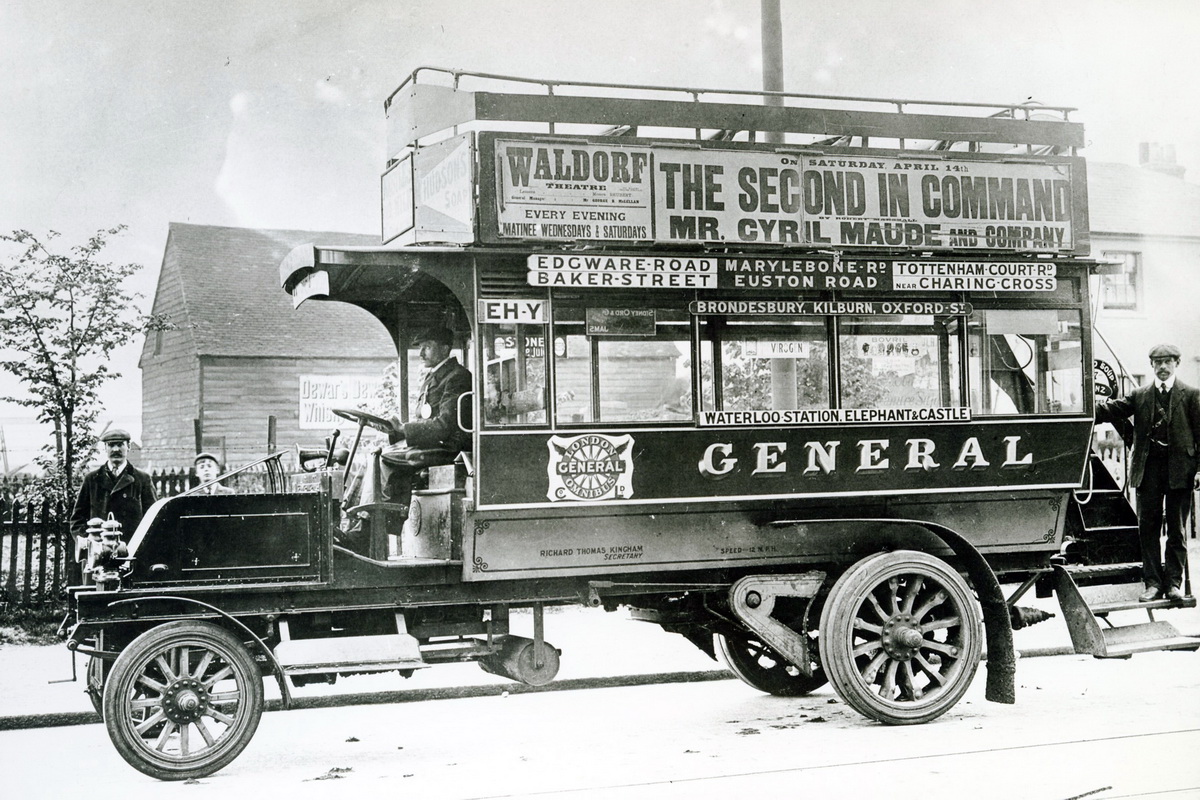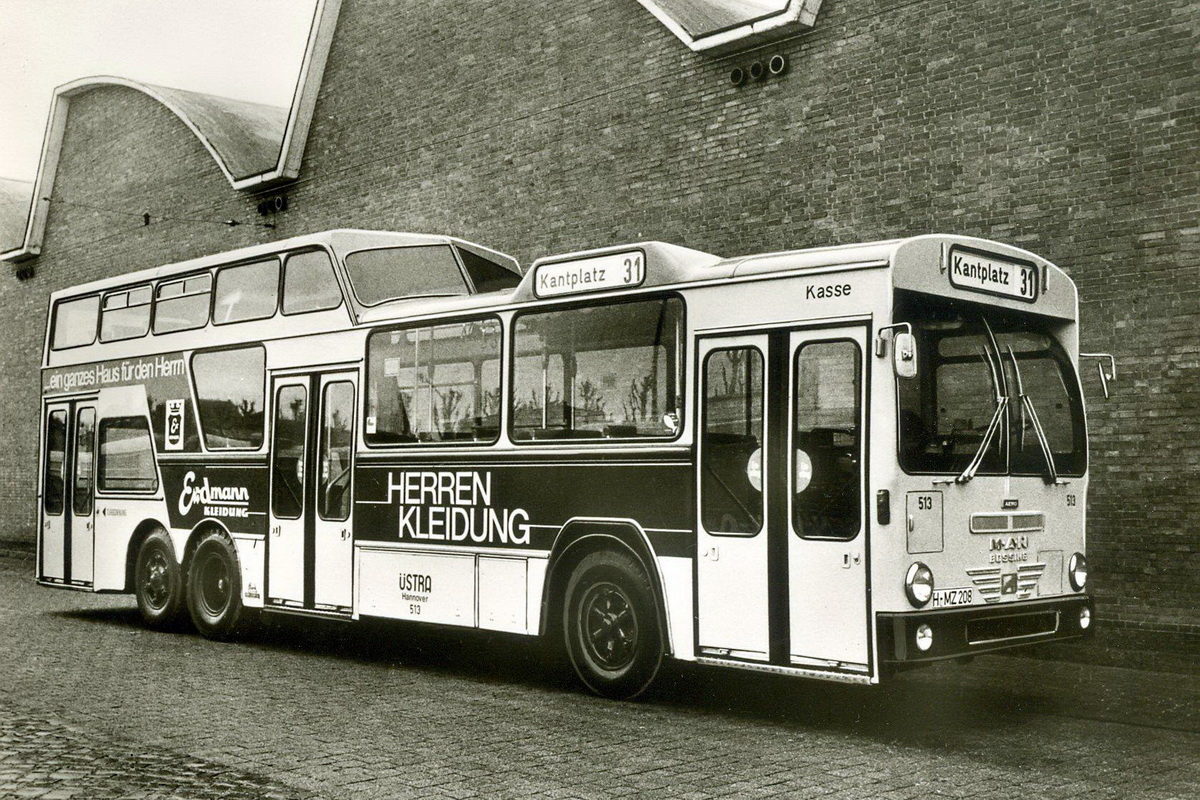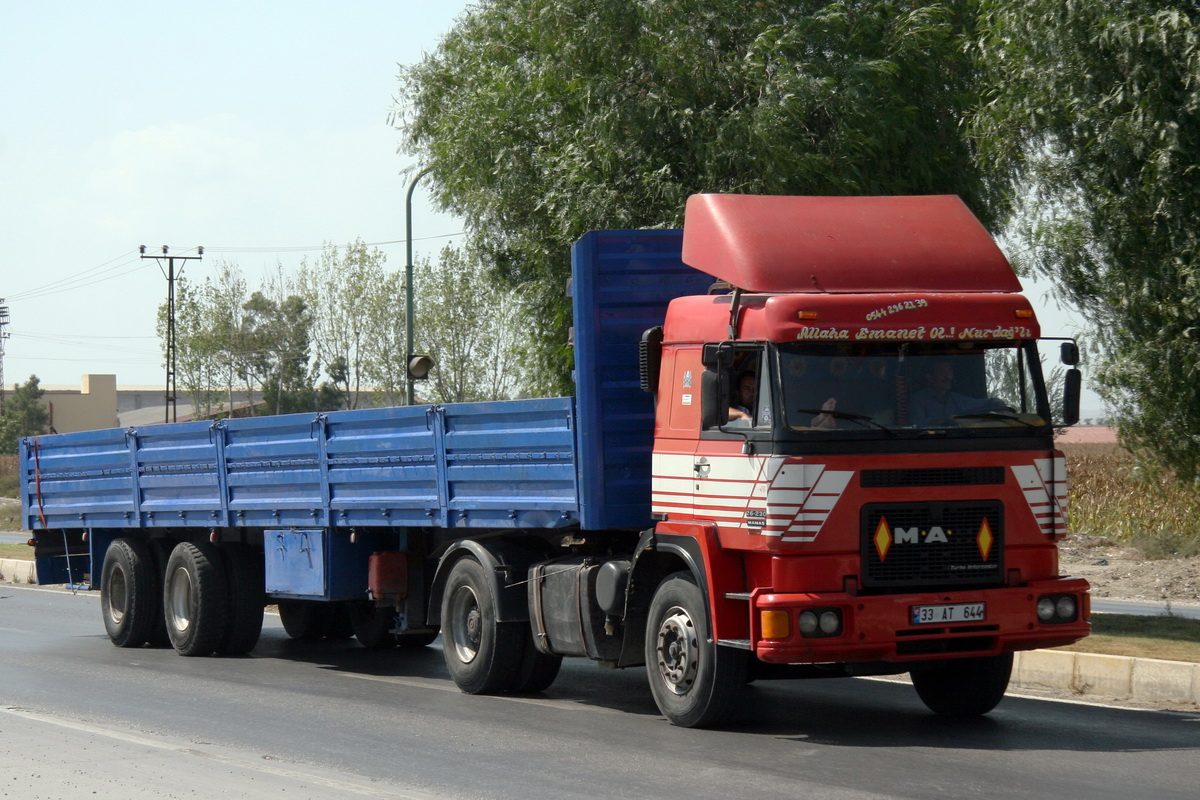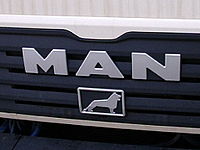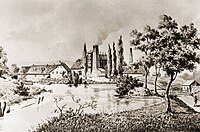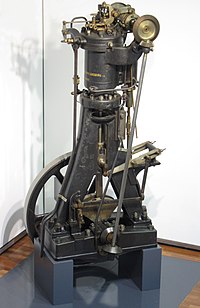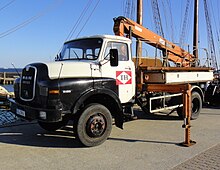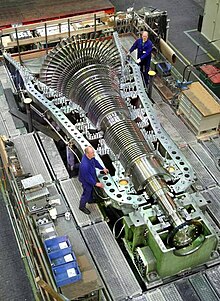В этом году исполняется 175 лет со дня рождения баварского инженера Генриха Бюссинга. Его имя уже мало что говорит постороннему человеку, но символ основанной им компании, рычащий лев, до сих пор красуется на решетках грузовиков марки MAN.
Генрих был талантливым инженером и одновременно успешным бизнесменом. Хотя занимался он сначала железнодорожным производством, его страстью всегда были грузовики и автобусы. В 1903 году он вместе с сыновьями одним из первых в Германии основал компанию по их выпуску. Таланты Бюссинга (а он получил около 250 патентов), его новаторство и предпринимательская жилка вскоре обеспечили фирме заметное место в сфере производства коммерческого транспорта.
Одни из первых английских даблдекеров с открытым вторым этажом были построены на шасси Büssing
Самым первым автомобилем марки Büssing стал десятиместный автобус с ременной трансмиссией, развивавший скорость 50 км/ч. Уже в 1904 году автобусные шасси выпускались массово — в частности, 400 штук были поставлены в Англию, где их оснастили двухэтажными кузовами. Всего через два года Бюссинг начал поставлять двухэтажные автобусы в Берлин, где они встречаются и поныне.
Трехосные полутораэтажники по имени President продолжали выпускаться и при новом хозяине
Следом Бюссинг создал свой первый 2,5-тонный грузовик с мотором мощностью 9 л.с. — на деревянных колесах с железными ободами. Но в то же время его компания начала сотрудничество с концерном Continental с целью разработки пневматических шин для коммерческого транспорта. Еще одной важной вехой стало создание в 1924 году первого в мире трехосного автобуса с колесной формулой 6х4.
В 1914 году грузовики Büssing уже имели карданный вал, электрические фары и пневматические шины
Генрих Бюссинг скончался в 1929 году, но его компания и в последующие годы была известна своими инновациями. К примеру, она создала междугородний автобус с двумя дизельными двигателями (1934 год), а также первый автобус с мотором, расположенным под полом (1949 год).
К 1950 году в компании трудилось больше четырех тысяч человек, собиравших по 200 автомобилей в месяц. Гамма грузовиков с грузоподъемностью 5—12 т с рядными дизелями состояла из нескольких серий.
Но расположенные в немецких городах Брауншвейге и Зальцгиттере заводы фирмы привлекли внимание компании MAN. В условиях усиливающейся конкуренции на рынке в 1967 году фирмы заключили соглашение о партнерстве, а в 1972-м MAN и вовсе выкупил Büssing целиком.
Хотя последние машины под маркой Büssing перестали выпускать еще в 1979 году, ее кабины до конца 1990-х использовал турецкий филиал фирмы MAN
Фирме Büssing неизменно сопутствовала слава производителя, который пользовался прогрессивными техническими решениями и чья продукция отличалась высоким качеством. Потому-то эмблему и было решено сохранить — отныне ею щеголяют грузовики и автобусы MAN.
МАН – это обозначение / логотип немецкой машиностроительной компании. В период своего основания компания называлась Maschinenfabrik Augsburg-Nürnberg.
Логотип MAN образован из первых букв названия компании – M. A. N. В чтении русского языка – МАН. Компания специализируется на производстве грузовых автомобилей (в том числе и самосвалов), танков (в период 2-й мировой войны), автобусов и двигателей.
Значок MAN является культовым. Он очень простой, но мужской и сильный. Состоящий из словесного знака и арки над ним, он показывает мощный и влиятельный бренд, уверенный в сегодняшнем и завтрашнем дне и стремящийся обеспечить высочайшее качество своих огромных автомобилей.
Серебристо-серая палитра логотипа МАН скромная и спокойная, однако на печатной версии фирменного стиля MAN можно увидеть разные тона букв — буква «А» окрашена в более светлый серый цвет, что придает строгому бренду игривости. .
При размещении на автомобилях эмблема серебристого цвета и выглядит массивно, уравновешивая пропорции грузовиков марки. Логотип MAN — один из самых минималистичных примеров визуальной айдентики автомобильного бренда, а также один из самых ярких и примечательных. Это показывает компанию как стабильную и неподвластную времени, опытную и прогрессивную.
«MAN Group» redirects here. For the British investment company, see Man Group.
 |
|
| Type | Public (Societas Europaea) |
|---|---|
| Industry | Manufacturing, automotive industry, marine engineering |
| Founded | 1758; 265 years ago[1] |
| Defunct | 31 August 2021; 2 years ago[2] |
| Fate | Merged into Traton |
| Headquarters | Munich, Germany |
| Products | Diesel and other engines, turbomachinery |
| Revenue | €13.6 billion (2016)[3] |
|
Number of employees |
53,824 (end 2016)[4] |
MAN SE (abbreviation of Maschinenfabrik Augsburg-Nürnberg, German: [maˈʃiːnənfaˌbʁiːk ˈʔaʊksbʊʁk ˈnʏʁnbɛʁk]) was a manufacturing and engineering company based in Munich, Germany. Its primary output was commercial vehicles and diesel engines through its MAN Truck & Bus and MAN Latin America divisions, and participation in the manufacturer Sinotruk.[5]
MAN SE was majority-owned by Traton, the heavy commercial vehicle subsidiary of automaker Volkswagen AG,[6] until August 2021 when Traton completed a squeeze-out of all remaining shareholders and formally merged MAN SE into Traton SE, meaning the former subsidiaries of MAN SE were now directly owned by Traton, and MAN SE ceased to exist.[7]
History[edit]
Foundation[edit]
MAN traces its origins back to 1758, when the «St. Antony» ironworks commenced operation in Oberhausen, as the first heavy-industry enterprise in the Ruhr region. In 1808, the three ironworks «St. Antony», «Gute Hoffnung» (English: «Good Hope»), and «Neue Essen» (English: «New Forges») merged, to form the Hüttengewerkschaft und Handlung Jacobi (English: «Jacobi Iron And Steel Works Union And Trading Company»), Oberhausen, which was later renamed Gutehoffnungshütte (GHH).[1]
In 1840, German engineer Ludwig Sander founded in Augsburg the first predecessor enterprise of MAN in Southern Germany: the «Sander’sche Maschinenfabrik». It firstly became the «C. Reichenbach’sche Maschinenfabrik», which was named after the pioneer of printing machines Carl August Reichenbach, and later on the «Maschinenfabrik Augsburg».[1]
The branch Süddeutsche Brückenbau A.G. (MAN-Werk Gustavsburg) was founded when the company in 1859 was awarded the contract for the construction of the railway bridge over the Rhine at Mainz.
In 1898, the companies Maschinenbau-AG Nürnberg (founded 1841) and Maschinenfabrik Augsburg AG (founded 1840) merged to form Vereinigte Maschinenfabrik Augsburg und Maschinenbaugesellschaft Nürnberg A.G., Augsburg («United Machine Works Augsburg and Nuremberg Ltd.»). In 1908, the company was renamed Maschinenfabrik Augsburg Nürnberg AG, or in short, M·A·N.
While the focus initially remained on ore mining and iron production in the Ruhr region, mechanical engineering became the dominating branch of business in Augsburg and Nuremberg. Under the direction of Heinrich von Buz, Maschinenfabrik Augsburg grew from a medium-sized business of 400 employees into a major enterprise with a workforce of 12,000 by 1913.
Locomotion, propulsion, and steel building were the big components of this phase. The early predecessors of MAN were responsible for numerous technological innovations. The success of the early MAN entrepreneurs and engineers such as Heinrich Gerber, was based on a great openness towards new technologies. They constructed the Wuppertal monorail («Wuppertaler Schwebebahn») and the first spectacular steel bridges such as the Großhesseloher Brücke in Munich in 1857 and the Müngsten railway bridge between 1893 and 1897.
The invention of the rotary printing press allowed the copious printing of books and newspapers, and since 1893, Rudolf Diesel puzzled for four years with future MAN engineers in a laboratory in Augsburg until his first diesel engine was completed and fully functional.
During 1921, the majority of MAN was taken over by the Gutehoffnungshütte Actienverein für Bergbau und Hüttenbetrieb, Sterkrade (GHH), (founded 1873).[1]
Through well-directed equities and acquisitions of processing industries, e.g., Deutsche Werft (1918), Ferrostaal (1921), Deggendorfer Werft und Eisenbau (1924), MAN advanced to a nationwide operating enterprise, with a workforce of 52,000 by 1921. MAN also produced tractors by the name MAN Ackerdiesel (1938-1962). The decision for tractor production was made due to increasing demand from eastern Germany.
Crisis and World War II[edit]
At the same time, the GHH’s economic situation worsened. The causes for this were, among others, the reparations after World War I, the occupation of the Ruhr region and the world economic crisis. In only two years, the number of MAN employees sank from 14,000 in 1929/30 to 7,400 in 1931/32. While the civil business was largely collapsing, the military business increased with the armament under the National Socialist regime. GHH/MAN enterprises supplied finished tanks, diesel engines for submarines and surface craft, and cylinders for projectiles and artillery of every description. Although MAN produced experimental diesel engines for tanks (Panzers), Maybach enjoyed a de facto monopoly on the design and manufacture of all tank and half-track engines, which were water-cooled, four-stroke motors. No diesel engines by any other manufacturer were installed in production armoured fighting vehicles during the war. MAN also produced gun parts, including Mauser Karabiner 98k rifle bolts. MAN’s Waffenamt code was WaA53, and ordnance code was «coc».
The MAN works in Augsburg, which produced diesel engines for U-boats and surface craft, and the MAN works in Nuremberg, which built 40% of Germany’s Panther tanks, were often the target of massive Allied bombing attacks during World War II.[1]
Postwar period[edit]
After the end of World War II, the allies split up the GHH group. A vertical integration, in which mining, iron, and steel production are consolidated, was not allowed anymore. The «Gutehoffnungshütte», together with the MAN firms of Southern Germany, therefore concentrated on engineering, plant construction, commercial vehicles, and printing machines.
This process has been supported by strategic acquisitions and dispositions; one of the most important was the take-over of the truck and bus division of the commercial vehicles manufacturer Büssing (1971), the disposition of the shares of the shipyard Deutsche Werft (1966/67), and the acquisition of the printing machine producer Faber&Schleicher, as well as its fusion to MAN Roland Druckmaschinen AG (1979).[1]
In 1980, MAN took control of Burmeister & Wain, the Danish company that had been a world leader in design and construction of large diesel engines for large ships.
In 1982/83, the «Gutehoffnungshütte» plunged into a deep corporate crisis. The enterprise suffered from the late effects of the second oil crisis and a bad economic situation. This was particularly displayed by the dramatic downturn of the commercial vehicle sales figures. Besides external factors, the chief course of these problems was the obsolete company structure with extensive cross-subsidisation between the divisions. At this time, the former director of GHH presented a reclamation concept that envisioned a complete consolidation of the subsidiary with the holding company. This concept encountered great resistance with GHH’s major shareholders Allianz AG and Commerzbank. The media speculated about a «Bavarian conspiracy» against the management in Oberhausen.[1]
In 1986, with Klaus Götte, the group got a new company structure and became a contractual group with an economically independent division at several locations. This was also attended by the transferring of the MAN headquarters from Oberhausen to Munich, and by the new company name, MAN AG.
Rudolf Rupprecht repelled a takeover attempt in 2003. Furthermore, the disposition of the 50% share of the SMS Group and the strengthening of the turbomachinery division through the takeover of Sulzer Turbo induced MAN’s focusing process.
In 2006, MAN entered into an agreement with Indian company Force Motors to establish a 50:50 joint venture for the production of trucks and buses in India for the domestic and export markets. The joint venture established a truck manufacturing plant in Pithampur, Madhya Pradesh, and launched its first truck for the Indian market in 2007. At the end of 2011, MAN bought out the stake of its Indian partner, and its operations in India became a wholly owned subsidiary of MAN in early 2012.[8][9] MAN ended production and sales in India and sold the Pithampur plant back to Force Motors in 2018.[10]
In September 2006, MAN produced an offer for the take-over of the Swedish competitor Scania AB. The European Commission approved the takeover on 14 December. Nevertheless, MAN voluntarily withdrew the offer on 23 January 2007, after Scania’s major shareholders Volkswagen AG and the influential Wallenberg family had declined the offer. On 24 December 2008, MAN published to possess further stock options of Scania and to therefore maintain more than 20% of the voting rights. As of October 2019, MAN SE still owns 17.37% of the voting rights in Scania, with the remainder of Scania being directly owned by Volkswagen Group’s heavy commercial vehicle subsidiary, Traton SE.
[11]
In 2008, the MAN group celebrated its 250th anniversary with numerous events, such as exhibitions in several museums, a vintage car tour with the motto «MAN on the road again», and a great anniversary gala. At the beginning of December 2008, MAN took over Volkswagen’s Brazilian truck and bus operation, Volkswagen Caminhões e Ônibus, putting the division under the control of MAN Latin America. Therewith, MAN now is a market leader in Brazil, with a market share of 30%.
Since May 2009, the group is incorporated as European corporation MAN SE.[12] In July 2009, MAN published to merge the two divisions, MAN Turbo and MAN Diesel, into one business area called Power Engineering. In addition, the group contracted a strategic partnership with Chinese truck manufacturer Sinotruk, purchasing 25% + 1 share of the company.
In the course of this focusing process, many smaller subsidiaries and divisions have been sold.
In 2009, investigators of the Munich Prosecutor’s Office uncovered a corruption affair, in which MAN had been bribing business partners and governments in over 20 countries from 2001 to 2007, to get large orders for buses and trucks. MAN CEO Håkan Samuelsson and other board members had to resign. The board of directors appointed Dr.-Ing. Georg Pachta-Reyhofen, the former CEO of MAN Diesel, as successor. On 17 December 2009, Pachta-Reyhofen was assigned as speaker of the board and CEO of MAN SE by the board of directors.
Takeover by Volkswagen[edit]
|
|
This section needs to be updated. The reason given is: future statements need to be updated and revised; note that the MAN brand still exists (despite the merger). Please help update this article to reflect recent events or newly available information. (May 2023) |
In July 2011, Volkswagen AG acquired a 55.9% voting stake and 53.7% of the share capital in MAN SE. Pending regulatory approval, Volkswagen planned to merge MAN and Scania AB to create Europe’s largest truck maker. The combined trucks group is planned to save about 400 million euros per year, mainly by bundling procurement.[13][14] Regulatory approval was granted, and the takeover was completed in November 2011.[15]
In April 2012, MAN SE announced that Volkswagen had increased its interest to a 73.0% voting stake and 71.08% of the share capital.[16]
On 6 June 2012, Volkswagen AG announced that it had increased its share of voting rights in MAN SE to 75.03%, paving the way for a domination agreement to be put in place.[17]
From January 2019, MAN’s Power Engineering division, made up of MAN Energy Solutions (formerly MAN Diesel and Turbo) and MAN SE’s 76% stake in RENK AG were sold to the Volkswagen Group, leaving MAN SE as the holding company for commercial vehicle units, MAN Truck & Bus, and MAN Latin America, under the responsibility of Volkswagen’s subsidiary, Traton SE.[citation needed]
In March 2019, MAN SE announced that 94.36% of its shares were held by Traton.[citation needed]
In February 2020, Traton announced that it intends to merge MAN SE with Traton to simplify the latter’s overall structure. As a result of the merger, MAN Truck & Bus, Scania AB, and Volkswagen Caminhões e Ônibus will become wholly owned, direct subsidiaries of Traton.[18]
In September 2020, the company announced that it will be cutting over 9,500 job positions at its MAN Truck & Bus division, as a result of the COVID-19 pandemic economic effects. The company made the move to generate €1.8 billion of cost savings by 2023.[19]
Legal issues[edit]
In 2011, a former manager in the company was charged with bribery of Turkmen state officials in exchange for project contracts in 2002. The trial began in Munich in 2019 after a delay of the initial trial set for 2016.[20][21] The MAN manager was suspected in giving 8.4 million euros in bribes in 2002–2007 to the head of the state-owned Turkmennebit company, Saparmammet Veliev.
See also[edit]
- ERF
- Gräf & Stift
- ÖAF
- Voith
- ZF Friedrichshafen
References[edit]
- ^ a b c d e f g «MAN SE — The MAN Group’s History — Industrial Pioneering». MAN SE. MAN.de. Retrieved 23 November 2009.
- ^ «TRATON successfully completes merger squeeze-out of MAN SE». TRATON SE. August 2021.
- ^ «Annual Report 2010» (PDF). MAN Group. Archived from the original (PDF) on 12 August 2011. Retrieved 3 April 2011.
- ^ «MAN SE Annual Report 2013» (PDF). Man Group. April 2013. Retrieved 28 April 2015.
- ^ «MAN Global Corporate Website». www.man.eu. MAN SE. 12 January 2014. Retrieved 12 January 2014.
- ^ MAN AG Annual Report 2016. MAN AG. 2016. p. https://www.corporate.man.eu/man/media/en/content_medien/doc/global_corporate_website_1/investor_relations_1/gb/2016_40/GB2016_DEU_geschutzt.pdf.
- ^ «TRATON successfully completes merger squeeze-out of MAN SE». TRATON SE. August 2021.
- ^ «Annual Press Conference — February 14, 2012» (PDF). MAN SE. Retrieved 22 February 2012.[permanent dead link]
- ^ «Ten years of MAN Truck & Bus in India». PressCenter. MAN SE. 16 September 2016. Archived from the original on 17 October 2016.
- ^ «Force Motors acquires MAN Trucks’ Indian manufacturing plant». financialexpress.com. 23 August 2018.
- ^ «MAN SE Company Presentation» (PDF). MAN SE. October 2019.
- ^ «MAN becomes a European stock corporation». www.man.eu. MAN SE. 26 May 2009. Archived from the original on 20 July 2011. Retrieved 17 December 2009.
- ^ «VW motors ahead with MAN-Scania truck merger plan». Reuters. 31 May 2011. Retrieved 16 August 2011.
- ^ «VW Moves on Trucks». Wall Street Journal. 5 July 2011. Retrieved 16 August 2011.
- ^ «VW Claims Victory». Commercial Motor. 27 November 2011. Retrieved 28 November 2011.
- ^ «Volkswagen hikes majority stake in truckmaker MAN». Reuters. 13 April 2012. Retrieved 10 May 2012.
- ^ «Volkswagen Group increases its share of voting rights in MAN SE to 75.03 percent». 6 June 2012. Archived from the original on 3 March 2016. Retrieved 6 June 2012.
- ^ «TRATON seeking to execute a squeeze-out of the non-controlling shareholders of MAN SE in accordance with merger law». 28 February 2020. Retrieved 14 March 2020.
- ^ Olaf Storbeck; Naomi Rovnick (11 September 2020). «German truckmaker MAN to cut up to 9,500 jobs». Financial Times. Archived from the original on 10 December 2022. Retrieved 12 September 2020.
- ^ RFE/RL’s Turkmen Service (11 December 2019). «Former German Manager On Trial For Bribing Of Turkmen Oil Officials». Radio Free Europe / Radio Liberty. Retrieved 12 December 2019.
- ^ «GIR Search — GIR — Global Investigations Review». globalinvestigationsreview.com. Archived from the original on 17 July 2020. Retrieved 15 July 2020.
External links[edit]
Wikimedia Commons has media related to MAN.
- Official website
- Documents and clippings about MAN SE in the 20th Century Press Archives of the ZBW
Значение эмблемы МАН, история, информация
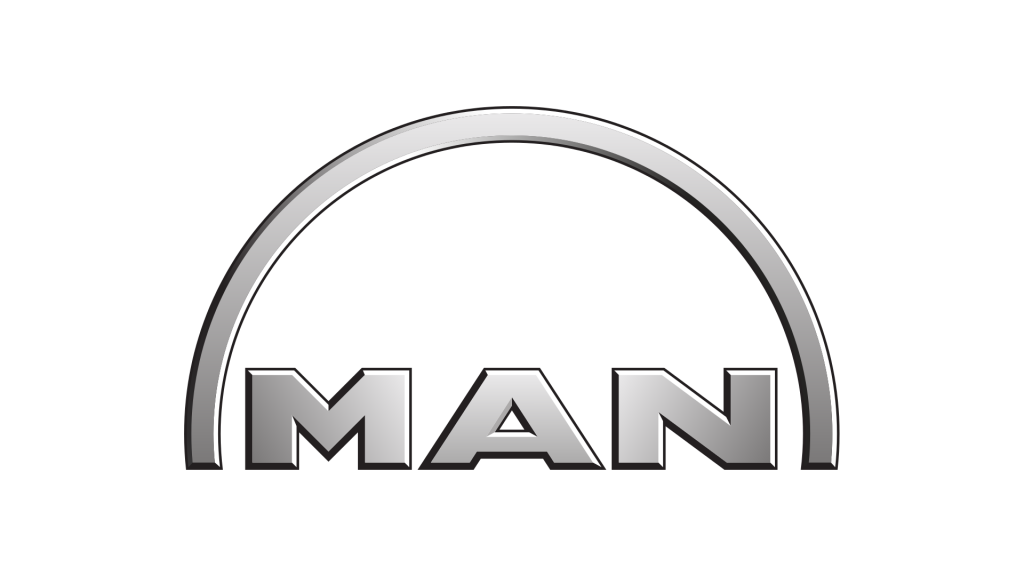
Вам также может быть интересно
MAN Logo PNG
MAN is one of the most recognizable brands of the heavy-trucks industry, which was established in 1758 in Germany and is owned by Volkswagen Group.
The name of the brand, MAN, which is highly recognizable all over the world, was derived from the original company’s name Maschinenfabrik Augustus-Nurnberg. Not many companies get that lucky with the first letters of their full names. MAN has one of the strongest branding concepts ever.
The MAN logo is also iconic. It is very simple but masculine and strong. Composed of a wordmark and an arch above it, it shows the powerful and influential brand, which is confident in today and tomorrow and aims to provide the highest quality of its huge automobiles.
The silver-gray palette of the logo is modest and calm, yet on the print version of the MAN visual identity you can see the different tones of the letters — the “A” featured a lighter gray, which adds some playfulness to a strict brand.
When placed on the cars, the emblem is silver and looks massive, balancing the proportions of the brand’s trucks.
The MAN logo is one of the most minimalistic examples of the car brand’s visual identity, as well as one of the most powerful and remarkable. It shows the company as stable and timeless, the experienced and progressive.
MAN Group — немецкий холдинг, который выпускает грузовые автомобили, автобусы и двигатели. Штаб-квартира располагается в Мюнхене. В состав компании входит три подразделения: — MAN Truck & Bus — один из ведущих производителей коммерческого транспорта в Европе.
Где собирают автомобили ман?
Помимо Европы производства MAN функционируют в Анкаре, Питампуре (Индия) и в городах ЮАР – Олифантсфонтейне и Пайнтауне. Совокупные продажи в сегменте коммерческого транспорта составили 11 млрд евро и 120 000 грузовых автомобилей, автобусов и автобусных шасси MAN, Volkswagen и Neoplan.
Как расшифровывается слово ман?
Городская вычислительная сеть (Metropolitan area network) — компьютерная сеть, по размерам меньше WAN, но крупнее LAN.
Где производят автобусы MAN?
Большая часть автобусов MAN и все туристические Neoplan сделаны на заводе компании MAN Truck and Bus SE в Турции. Ежегодно предприятие в Анкаре выпускает до 3950 транспортных средств, которые затем большим потоком растекаются по всему миру.
Как называются американские грузовики?
Американский трак Freightliner (Портленд, штат Орегон, 1942-…) Компания грузоперевозок Consolidated Freightways была основана Лиландом Джеймсом в 1929 году, а с 1942-го начала строить собственные машины под брендом Freightliner (буквально – «грузовой лайнер»).
Что означает логотип MAN?
Название M. A. N. (Maschinenfabrik Augsburg-Nürnberg) произошло от основанной в 1840-м году машиностроительной фабрики, которая до начала 1980-х входила в концерн GHH.
Что изображено на логотипе MAN?
Логотип автомобилей MAN — Брауншвейгский лев, изображенный на гербе компании Büssing Automobilwerke.
Что является эмблемой?
Эмблема (др. -греч. ἔμ-βλημα — вставленная часть, инкрустация) — условное изображение отвлечённого понятия, идеи в рисунке или пластике, содержание которых не может быть изображено непосредственно, иконически. Поэтому в семиотике эмблему относят к неиконическим, или условным, знакам.
Что изображено на эмблеме Манчестер Сити?
Долгое время клуб играл под гербом Манчестера. Изображение использовалось с 1894 по 1964 год. Знаменитый корабль в композиции олицетворяет судоходный канал Манчестера. С шестидесятых годов прошлого века «Манчестер Сити» начинает использовать круглый логотип со щитом и кораблем.
Где выпускают грузовики Scania?
Scania AB — шведский производитель грузовых автомобилей, автобусов, промышленных и морских двигателей. Выпускает автобусы с 1920 года. Штаб-квартира располагается в городе Сёдертелье, Швеция. Производство находится в Швеции, Франции, Нидерландах, Аргентине, Бразилии, Польше и России.
Какие грузовики собираются в России?
Их доля в общем производстве грузовых автомобилей в России в 2011 году составила 84 %.
- КамАЗ
- УАЗ
- ЗИЛ
- Группа ГАЗ
- Группа «Соллерс»
- ТагАЗ
- ЗАО «Вольво Восток»
- ООО «Ивеко-АМТ»
Где собирают сканию в России?
Завод в Санкт-Петербурге
Завод, расположенный в Санкт-Петербурге в индустриальной зоне Шушары, является единственным предприятием на территории России по производству техники Scania и рассчитан на выпуск любых видов грузовых автомобилей.
Кто на логотипе ман?
В этом году исполняется 175 лет со дня рождения баварского инженера Генриха Бюссинга. Его имя уже мало что говорит постороннему человеку, но символ основанной им компании, рычащий лев, до сих пор красуется на решетках грузовиков марки MAN.
Можно ли использовать государственную символику?
Верховный суд Российской Федерации поддержал эти доводы, подчеркнув, что обычным гражданам и их объединениям запрещено использовать не только непосредственно изображение Государственного герба, но и другие схожие до степени смешения изображения.
Что такое логотип простыми словами?
Логотип – это индивидуальный графический знак (рисунок), шрифтовое написание марки или сочетание графического знака и шрифтового написания. Цель логотипа – донести до целевой аудитории компании ее идею.
Как называется логотип компании?
Графический элемент рядом с лого или, используемый в качестве отдельного компонента корпоративного стиля называется фирменным знаком. Он может быть абстрактной формы, в виде символической или буквальной иллюстрации.
( 1 оценка, среднее 5 из 5 )


